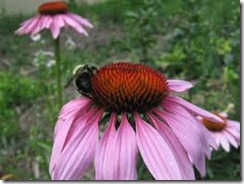Purple coneflowers, also known by the genus name Echinacea, are a hardy perennial and versatile wildflower. Bees and butterflies are attracted to the flowers in summer; the seeds become a favorite of birds in fall and winter. As an herb, Echinacea is commonly used to help fight off the common cold, and is used in herbal teas.
Characteristics
-
Purple coneflowers grow 2 to 4 feet in height, forming clumps that can be divided and transplanted within two years. They reseed, but are easily controlled and are not invasive. Mature plants have single flower heads on long stalks that rise above coarsely toothed leaves. The flowers resemble daisies, with petals in a ray around a conical center. The most common flower colors range from purple to pink. Newly developed colors in the coneflower family include white, red, yellow and orange. Coneflowers prefer full sun. The leaves of native coneflowers are narrower than those of their hybrid cousins.
Native Coneflowers
-
A native of North America, the purple coneflower has adapted to a wide variety of growing conditions. A common choice for naturalized plantings, they are a hardy perennial, require no care, can grow in poor soil conditions and tolerate drought. Purple coneflowers thrive in the wild in roadside ditches, prairie areas, fence lines and meadows. They enjoy legal protection in some states, and should not be harvested from the wild.
Herbal Remedies
-
Purple coneflowers are commonly cultivated and harvested for medicinal use. Native Americans used these plants for ailments from sore throats and wounds to toothaches. Today parts of the coneflower, marketed under its genus name Echinacea, find their way into supplements, teas, and herbal remedies. Some modern uses include ingesting the herb to shorten the length of the common cold, treating ear infections and hay fever, and healing wounds. This plant may boost the immune system with regular use. Consult your physician before using Echinacea to treat symptoms, as it can interact with some medications and may be contraindicated for certain health conditions.
Garden Flowers
-
Purple coneflowers in cottage gardens add to the riot of color, offering a bloom time that lasts from late summer through fall. Because they are not invasive they can be tucked in among other plants for a full look. Coneflowers make an attractive nice backdrop for border plants and midsized annuals of 6 to 12 inches tall. They grow quickly enough to provide moderate shade for low-growing neighboring plants.


Deprecated: strpos(): Passing null to parameter #1 ($haystack) of type string is deprecated in /home/agriviek8Qv/agriviet.net/public_html/wp-includes/comment-template.php on line 2522